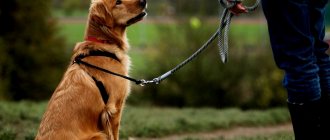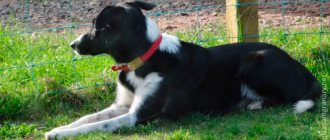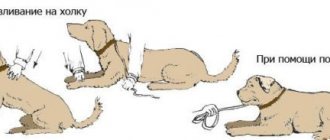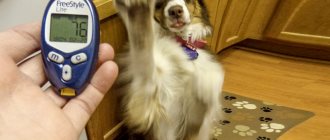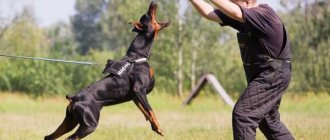No one wants to have a pet in the house whose behavior creates small problems, and especially no one wants a dog the size of a German shepherd that can cause complete destruction in the apartment. But a dog that unquestioningly obeys the owner and members of his family is suitable for everyone, does what the owner requires during a walk, and does not get lost from his field of vision. Sometimes it can be difficult to get the desired behavior from a pet, so every dog owner must know how to teach a dog to follow commands.
Kiss
Yes, your dog may already shower you with kisses on a daily basis, but now you can teach them to kiss you on command. This video will take you through the learning process, step by step, showing you how to work your way up to the final kiss. For this trick you will need something sticky like tape or a sticker, treats and a clicker. The dog in this training video not only learned to kiss his hands, but he even learned to kiss his cat friend!
Features of training an adult dog
Correcting behavior and training an adult animal is more difficult than a puppy. The dog has an established psyche, fixed patterns of behavior that are problematic to correct. On average, it takes from 3 months to a year to learn basic commands for an adult dog. It requires patience and a lot of time. Peculiarities:
- identify the animal’s temperament and adjust training methods accordingly;
- try not to show negative emotions;
- do not make sudden movements if the dog is inclined to show aggression;
- talk to the dog while working;
- choose a suitable treat;
- alternate exercises, change the location for walks.
The fastest way to train an adult dog is to use physical training methods (a response is developed to physical influences), using an EShO.
However, the electric collar is difficult to use (it is easy to hurt the dog), and it cannot be used without the supervision of a dog handler.
Bark On Command
This trick may be for more experienced dogs and takes some extra patience as it is one of the more difficult tricks. As the video shows, you have to be diligent in waiting for your dog to bark at you first, and then reward them as they constantly do. The dog in the video won't bark right away even if the trainer is a professional, so make sure you remember that this won't happen right away. However, if you can master it, barking on command is a very unique trick that will definitely amaze your fellow dog owners.
Basic Commands
What commands must be taught?
Basic commands:
- near;
- lie;
- sit;
- give me your paw;
- it is forbidden;
- stranger;
- stand;
- bring;
- wait;
- take a walk.
These exercises will be needed to develop mobility, dexterity, intelligence and obedience.
But such commands as spin, hurdle, somersault, die, seek and fetch are considered quite complex; not all dogs perform them and only at a more mature age. For this, the pet must be rewarded with food and the exercises must be repeated constantly.
How to teach a dog a voice command
The “voice” command is especially useful for those dogs that are used for hunting, when guarding a home, or in the process of searching for people. But initially you need to take into account that some breeds will not be able to learn at all and bark loudly, and Labradors and shepherds learn the fastest. How to teach a dog a voice command?
Follow these guidelines:
- tie the dog near a tree and step on the leash;
- do not let your pet jump on you when he sees food;
- ask for a voice and show a tasty treat;
- reward your pet after following a command;
- repeat the exercise two to three times.
It is important not to reward the animal if it barks and barks without a command, otherwise the exercise will be remembered incorrectly.
Lie
The “lie down” command can also be useful in everyday life, especially if you travel a lot with your pet or often visit. Training begins at three months, simultaneously with the “sit” command. If the command is carried out correctly, give a treat, and if there is no reaction, press on the withers. How to teach a dog the command to lie down?
Easy, all you need is:
- go to a quiet place, even outside. But there should be no dampness or snow on the ground;
- press on the withers and back, saying “lie down” ;
- at this time you need to show the tasty treat in your other hand at ground level;
- After following the instructions, let the animal go for a walk.
Remember that training can take up to a year, but it should be done without rudeness, gradually becoming more difficult. If at first the pet is trained at home, then later, on the street or in a public place.
And don’t expect that the dog will be able to lie on the ground for a long time the first time.
Shake hands
The “shake hand” trick is definitely one of the cuter tricks your puppy can learn. It's quite simple and is actually one of the easiest tricks to teach. The secret is that your dog will already naturally put his paw on you if they want something. When you present a closed handful of treats, your pet will be forced to paw on your hand since they cannot treat with their mouth. As soon as they continue pawing, start using the command “Give paw” and repeating it several times, your dog is sure to learn a new trick.
Bring
And fetch is a classic game; for some dogs it's deception, which doesn't come naturally. It can get quite frustrating when your dog doesn't cooperate during playtime. Some dogs are not interested in toys and don't even want to try, some will go and fetch the toy but won't return it, and then there are stubborn dogs that will bring the toy back but then won't let go. Watch this tutorial to see how you can get your dog interested in fetch in the first place, and then actually learn how to play fetch correctly.
Play Dead
“Playing Dead” is a great trick that is sure to impress your friends and families. Unlike simple commands such as sit or shake hands, playing dead takes a little more time and persistence to master. This tutorial uses the reverse approach, teaching the last part of the trick first for the dog to learn more easily. Take your time and remember to reinforce with a clicker and treats to make the process faster. If your dog already knows the “roll over” trick, then it will be much easier for them to learn this trick.
Where to start teaching your dog commands
It is recommended to teach the puppy commands from a very early age, when the dog comes into active contact with the owner. Depending on the breed, this is 4-6 months, but adult individuals can also correct their behavior - it will take more time. Before starting classes, get all the necessary vaccinations and check the puppy’s health (hearing, vision and coordination). Dog handlers recommend getting the dog to contact you and respond to your name - this will make it easier to interact with the animal during training.
At home
It is recommended to teach commands through games and the feeding process. It is necessary to ensure that the puppy perceives his name well and responds to it when exposed to any stimuli. In addition, you need to teach your pet to comfortably accept the collar and leash. You can put on ammunition from a very young age so that the animal begins to get used to the process.
Establishing contact with your pet while feeding is a simple initial exercise. To do this, you need to pour food into a bowl and do not let the dog near it. Get her to look into your eyes; eye contact should be for at least 5 seconds. Then let your pet eat. After teaching the “sit” command, this process can be complicated by sitting the dog at some distance from the bowl.
On the street
Before starting active training, you should teach the dog to respond to a name against the background of smells and sounds on the street, and to calmly tolerate walking on a leash. After your puppy's routine vaccination, you can start going for walks. You should use a short leash, which makes it easier to achieve contact and control.
If your pet loves active games and there is an area with a fence, it is useful to use a ball outside. Your task is to throw the ball, and the dog must return to you. There is no need to worry if the puppy does not give up the toy at first; the main task at this stage is to teach the dog to respond to your voice and return. You should start training classic commands when you learn to quickly find contact with your pet - this increases the effectiveness of the training.
Back
Getting your dog on his back on command is one of the main dog pranks. Although seemingly difficult, doing your dog's back when directed can be done very easily with the right technique. The instructor in the video shows you how to start with a treat and eventually get just a voice command. However, getting your dog on his back with a voice command alone can be quite difficult for newbies, so even if you get your dog on his back with a hand, cue or treat, then it is still an achievement to be celebrated.
First stage: training in basic commands
"Ugh"
The prohibitive command is the most important stage of training. It is one of the main skills, after the nickname.
Training is based on the carrot and stick principle . A loud exclamation of “fu” is accompanied by negative reinforcement - a jerk with a leash, a slap on the rump with a newspaper. Immediately after the cessation of the unwanted action, use positive reinforcement (praise, treat, toy).
It’s better to start practicing the skill at home, teach him to spit out toys, as if exchanging a toy for food. You can simulate throwing food on the street. While feeding the puppy by hand while walking, you “accidentally” drop a piece. As soon as the pet tries to pick up the food, you need to stop it by holding the dog and commanding “fu”. Immediately give another piece of treat from your hand. Systematic repetition of this exercise shows positive results in practice. In addition, you can teach your dog to eat from his bowl only after the command “maybe”. This will help the puppy understand that all food belongs to the owner, and it cannot be taken until the command is given.
The pet quickly grasps the connection between behavior, prohibition of action, execution of a command and receiving a treat. And also quickly learn to execute a command.
When training any team, the main thing is consistency. You cannot allow it once, then prohibit it and then allow it again. Only a constant, identical reaction to the same action will teach your pet to quickly follow orders.
"Place"
A dog should have a place in the house. In which she feels comfortable - a cozy corner without drafts. It is advisable to have a view of the area and the front door from the spot; this will make the pet feel calmer. It is better if there is a wall on one side of the bedding - a protected rear will add confidence to the animal.
You cannot punish a dog for misbehavior while it is on its bedding. The dog's place should be associated only with positive emotions; if the puppy behaved badly and hid on the bedding from punishment, all punitive measures must be stopped immediately.
In order for the dog to quickly remember the command “place” and have pleasant associations, you need to throw a piece of treat on the bedding and say the command. Naturally, the puppy will run for food, while he is eating, you need to approach him, once again reinforcing him with a treat and praise “well done, place.” To consolidate the skill, the exercise must be repeated daily, several times a day.
"To me!"
Another important command is “to me.” Full management of an animal in an urban area that cannot run up to the owner’s call is impossible. When training the “come to me” order, it is strictly forbidden to use negative reinforcement, otherwise the training will not only be delayed - the pet will completely refuse to approach the owner. You need to start training on a leash, only after 10 approaches out of 10 can you start letting the dog go.
The training proceeds as follows:
- When the dog is distracted and moves away from the owner or sniffs at someone’s mark, you need to pronounce the name loudly or attract the pet’s attention in another way (whistle, clapping your hands).
- As soon as the puppy’s attention is attracted, you need to clearly say “Come!” and start moving away from the dog, for kids this becomes a fun game of catch. Or show your pet a treat; if he is hungry, he will definitely run for the treat.
- While the puppy is running, you must definitely praise and encourage him in a cheerful voice.
- When the puppy runs up, immediately give him food or start a short game, without ceasing to praise and stroke him.
This command is learned very quickly - the dog enjoys not only receiving rewards, but also the admiration of the owner.
"Give me your paw"
When training, methods of positive and negative reinforcement are used. A treat is taken in your hand - what the dog loves most. The treat is clenched in the fist. With your hand outstretched, you need to give the command “Come to me”, repeat it periodically.
The puppy will try to get the treat in different ways; it will try to bite, lick, and poke its nose. Misbehavior should be responded to with a prohibition order (negative reinforcement). But as soon as the baby touches his hand with his paw, at the same moment open his palm and give the food, praising the puppy.
Repeat 3 – 4 times, periodically changing hands so that the dog follows the order from either hand.
Full article on this topic: “Teaching the command “Give me your paw!”: training methods from a dog handler.”
"Sit"
You need to take a piece of treat in your fist and bring it to the dog’s nose . Slowly move the hand with the piece from the muzzle up and slightly back so that the pet raises its head while chasing the food. At this moment, you need to say the command “sit” and raise the treat a little higher. Trying to reach, the dog will sit instinctively. If the dog is overexcited and starts jumping, demanding to give food, you need to fix the head by the collar and put a little pressure on the croup. After completing the order, it is necessary to reward and give away the “yummy”.
"Lie"
When the dog knows the “Sit” command, sit the puppy in front of you, showing the treat in your hand.
Say the command “Lie down” and move the hand with the treat clamped in it down in front of the dog’s nose, towards the front paws. The dog will instinctively stretch and lie down. As soon as the command is completed, repeat “Lie down”, immediately give the treat and praise.
"Voice"
When a dog sees any irritant - be it a cat, another dog, some object and begins to bark, you need to command “Voice” and, while the dog is barking, praise and encourage . The puppy will not immediately understand why in some cases he is scolded for barking, and in other cases he is encouraged. The vocal command should be given every time the dog barks so that the action is reinforced. If the dog starts barking without the “Voice” command, you should ignore it, completely ignoring this behavior.
Practicing this command will allow you to correct unwanted behavior.
"Near"
The “near” command is the only repeating order, which must be spoken several times while moving. The main position is that the pet sits at the handler’s left leg. The beginning of the movement corresponds to the command. After pronouncing the order, you need to start moving, while at the same time not losing the puppy’s attention with the help of a toy or treat. In the first stages of training, you need to praise your pet every few steps. After successfully passing 2 - 3 meters, let them go for a walk.
"Aport"
This command is most easily practiced with young dogs during play. When throwing any objects (a stick, a ball or your favorite soft toy), command “Fetch.” Reinforcement of the team in this case is receiving the treasured toy.
Fetching a toy can be trained using the order “Come to me” immediately after the dog has picked up the fetch object.
Stand on your hind legs
While this trick may seem like something left to the professionals, if you are a dog owner who is persistent, patient, and has high determination, it is definitely doable. Compared to tricks like “shake hands” or “spin” this trick may seem complicated, but in reality it is simple and easy to achieve if you put in the work and dedication. Big or small, any dog can learn this if their owner is equally determined.
Sit Pretty
Making your dog “sit pretty” isn't just fun because it gives you a chance to take cute photos of your puppy to post on Instagram, but it's also great exercise for your dog. Making your dog kick is an adorable pose that helps with your dog's balance and can build core muscles. However, make sure your dog is healthy for this trick because it can be stressful for dogs with pre-existing conditions.
Why does a dog need to know commands?
Command training establishes a bond between dog and owner with an emphasis on human leadership. The dog needs to prove that the owner is an indisputable authority. A tool for managing a large dog appears.
The dog is ready for training
Training disciplines the animal and develops its intelligence. Breeds such as the husky or the German shepherd begin to feel sad if the owner does not give them commands for a long time.
Hug
While you can always just give your dog a hug, this trick is neat because your dog will actually put his paws around you and hug you. Who wouldn't want to learn this amazing trick? If you want to master this touching hug just remember to be aware of the pace at which your dog learns. Also, keep in mind that it is a little easier for your dog to learn this trick if they already know “sit pretty,” but otherwise it is still very manageable.
Who, when and how to teach?
Almost all tricks require concentration from the dog, which means that training begins no earlier than 4 months of age. There is no upper age limit; if the dog is active, loves to walk and spend time with the owner, then it can learn. Next, a little about stereotypes, it is believed that certain breeds of dogs are not capable of performing tricks, and they are difficult to train. In fact, any pet can be taught a variety of skills, but does the dog itself want this?
If you are now perked up, but the phrase flashes through your head: “If he doesn’t want to, we’ll force you”, moderate your ambitions. Trickstering is a game, its foundations lie in motivation and positive training methods, without the use of punishment or harsh pressure. The right way is to work on relationships; the pet should strive to please you. Always remember for what purpose you got a dog, because some working breeds do not recognize games at the “genetic level”.
Important! Pets with a melancholic and phlegmatic character will prefer to lie at the feet of the owner than to tumble and jump through hoops - respect the needs of your pet!
Next, let's look at what tricks you can teach a dog at the initial stage. Remember that trickery is a team effort that should bring mutual pleasure. Choose exercises based on your existing skills. Don’t force things and initially train your pet to work in any conditions – on the street, at home, at a party.

